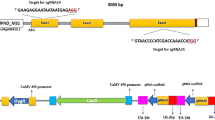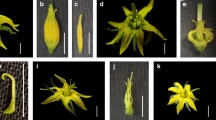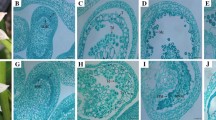Abstract
Key message
We characterized the photoperiod-sensitive 7B - 1 male-sterile mutant in tomato, showing its allelism with stamenless - 2 . Mapping experiments indicated SlGLO2 , a B-class MADS-box family member, as a strong candidate to underlie the 7B - 1 mutation.
Abstract
The interest in male sterility (MS) dates back to a long time due to its perspective use in hybrid seed production. Here, we characterize 7B-1, a photoperiod-sensitive male-sterile (ms) mutant in tomato (Solanum lycopersicum L.), in which stamens are restored to fertility by permissive growth conditions in short days (SD). This system represents a useful strategy to facilitate the maintenance of the ms line. Examination of 7B-1 and other structural mutants, vms, sl, sl-2 and tap3, showed carpellization of stamens in the third floral whorl. 7B-1 exhibits strong expressivity in long days (LD), producing 100% aberrant anthers and virtually no seed production under open pollination, whereas it recovered fertility in SD. By genetic analysis, we demonstrate that 7B-1 is not allelic to sl nor to vms; instead it shows allelism to sl-2. Because the homeotic phenotype of the mutation resembles lesions to members of the B-class MADS-box transcription factor family, that specify petal and stamen identity, we pursued a candidate gene approach towards these targets. Using an interspecific backcross mapping population and markers linked to B-class MADS-box genes, significant linkage was found between 7B-1 and the SlGLO2 gene on Chr6. This result was supported by the 7B-1 phenotype that is similar to that of SlGLO2 knock outs and by the strong downregulation of the gene in the mutant. Although the lesion underlying the mutant phenotype is still elusive, our results pave the way for the final demonstration that SlGLO2 underlies 7B-1 and further the use of 7B-1 mutant in tomato hybrid seed production schemes.




Similar content being viewed by others
References
Atanassova B, Georgiev H (2002) Using genic male sterility in improving hybrid seed production in tomato (Lycopersicon esculentum Mill.). Acta Hortic 579:185–188
Bai Y, Lindhout P (2007) Domestication and breeding of tomatoes: what have we gained and what can we gain in the future? Ann Bot 100:1085–1094
Bergougnoux V, Hlavackova V, Plotzova R, Novak O, Fellner M (2009) The 7B-1 mutation in tomato (Solanum lycopersicum L.) confers a blue light-specific lower sensitivity to coronatine, a toxin produced by Pseudomonas syringae pv. tomato. J Exp Bot 60:1219–1230
Bishop CJ (1954) A stamenless male-sterile tomato. Am J Bot 4:540–542
Bowman JL, Smyth DR (1999) CRABS CLAW, a gene that regulates carpel and nectary development in Arabidopsis, encodes a novel protein with zinc finger and helix–loop–helix domains. Development 126:2387–2396
Busi MV, Bustamante C, D’Angelo C, Hidalgo-Cuevas M, Boggio SB, Valle EM, Zabaleta E (2003) MADS-box genes expressed during tomato seed and fruit development. Plant Mol Biol 52:801–815
Chen J, Hu Q, Zhang Y, Lu C, Kuang H (2014) P-MITE: a database for plant miniature inverted-repeat transposable elements. Nucleic Acids Res 42(D1):D1176–D1181. doi:10.1093/nar/gkt1000
Coen ES, Meyerowitz EM (1991) The war of the whorls: genetics interactions controlling flower development. Nature 353:31–37
Coker JS, Davies E (2003) Selection of candidate housekeeping controls in tomato plants using EST data. Biotechiniques 35:740–742
de Martino G, Pana I, Emmanuel E, Levy A, Vivian F, Irish VF (2006) Functional analyses of two tomato APETALA3 genes demonstrate diversification in their roles in regulating floral development. Plant Cell 18:1833–1845
Díez MJ (1999) Tipos varietales. In: Nuez F (ed) El cultivo del tomate. Mundi Prensa, Madrid, pp 93–129
Doyle JJ, Doyle JL (1990) Isolation of plant DNA from fresh tissue. Focus 12:13–15
Eshed Y, Zamir D (1995) An introgression line population of Lycopersicon pennellii in the cultivated tomato enables the identification and fine mapping of yield-associated QTL. Genetics 141:1147–1162
Fellner M, Sawhney VK (2001) Seed germination in a tomato male sterile mutant is resistant to osmotic, salt and low temperature stresses. Theor Appl Genet 102:215–221
Fellner M, Sawhney VK (2002) The 7B-1 mutant in tomato shows blue-light-specific resistance to osmotic stress and abscisic acid. Planta 214:675–682
Fellner M, Zhang R, Pharis RP, Sawhney VK (2001) Reduced deetiolation of hypocotyl growth in a tomato mutant is associated with hypersensitivity to, and high endogenous levels of abscisic acid. J Exp Bot 52:725–738
Foolad MR (2007) Genome mapping and molecular breeding of tomato. Int J Plant Genom 2007(64358):1–52. doi:10.1155/2007/64358
Frankel R (1973) The use of male sterility in hybrid seed production. In: Moav R (ed) Agricultural genetics. Wiley, New York, pp 85–94
Fulton TM, van der Hoeven R, Eannetta N, Tanksley S (2002) Identification, analysis and utilization of a conserved ortholog set (COS) markers for comparative genomics in higher plants. Plant Cell 14:1457–1467
Geuten K, Irish VF (2010) Hidden variability of floral homeotic B genes in Solanaceae provides a molecular basis for the evolution of novel functions. Plant Cell 22:2562–2578
Gómez P, Jamilena M, Capel J, Zurita S, Angosto T, Lozano R (1999) Stamenless, a tomato mutant with homeotic conversions in petals and stamens. Planta 209:172–179
Guo X, Hu Z, Yin W, Yu X, Zhu Z, Zhang J, Chen G (2016) The tomato floral homeotic protein FBP1-like gene, SlGLO1, plays key roles in petal and stamen development. Sci Rep 6:20454. doi:10.1038/srep20454
Hafen L, Stevenson EC (1958) Preliminary studies of five stamenless mutants. Tomato Genet Cooper Rep 8:17–18
Hemming MN, Trevaskis B (2010) Make hay when the sun shines: the role of MADS-box genes in temperature-dependant seasonal flowering responses. Plant Sci 180:447–453
Hlavinka J, Nauš J, Fellner M (2013) Spontaneous mutation 7B-1 in tomato impairs blue light-induced stomatal opening. Plant Sci 209:75–80
Kaul MLH (1988) Male sterility in higher plants. Springer, Berlin
Kempken F, Pring DR (1999) Male sterility in higher plants- fundamentals and applications. Prog Bot 60:139–166
Kramer EM, Irish VF (1999) Evolution of genetic mechanisms controlling petal development. Nature 399:144–148
Kramer EM, Dorit RI, Irish VF (1998) Molecular evolution of genes controlling petal and stamen development: duplication and divergence within the APETALA3 and PISTILLATA MADS-box gene lineages. Genetics 149:765–778
Lamb RS, Irish VF (2003) Functional divergence within the APETALA3/PISTILLATA floral homeotic gene lineages. Proc Natl Acad Sci 100:6558–6563
Lee S, Lee S, Yang K-Y, Kim Y-M, Park S-Y, Kim SY, Soh M-S (2006) Overexpression of PRE1 and its homologous genes activates gibberellin-dependent responses in Arabidopsis thaliana. Plant Cell Physiol 47:591–600
Leseberg CH, Eissler CL, Wang X, Johns MA, Duvall MR, Mao L (2008) Interaction study of MADS-domain proteins in tomato. J Exp Bot 59:2253–2265
Livak KJ, Schmittgen TD (2001) Analysis of relative gene expression data using real-time quantitative PCR and the 2−ΔΔCt method. Methods 25:402–408
Longin CF, Mühleisen J, Maurer HP, Zhang H, Gowda M, Reif JC (2012) Hybrid breeding in autogamous cereals. Theor Appl Genet 125:1087–1096. doi:10.1007/s00122-012-1967-7
Lozano R, Angosto T, Gómez P, Payan C, Capel J, Huijser P, Salinas J, Martınez-Zapater JM (1998) Tomato flower abnormalities induced by low temperatures are associated with changes of expression of MADS-box genes. Plant Physiol 117:91–100
Mara CD, Huang T, Irish VF (2010) The Arabidopsis floral homeotic proteins APETALA3 and PISTILLATA negatively regulate the BANQUO genes implicated in light signaling. Plant Cell 22:690–702
Mazzucato A, Taddei AR, Soressi GP (1998) The parthenocarpic fruit (pat) mutant of tomato (Lycopersicon esculentum Mill.) sets seedless fruits and has aberrant anther and ovule development. Development 125:107–114
Mazzucato A, Olimpieri I, Siligato F, Picarella ME, Soressi GP (2008) Characterization of genes controlling stamen identity and development in a parthenocarpic tomato mutant indicates a role for the DEFICIENS ortholog in the control of fruit set. Physiol Plant 132:526–537
Nash AF, Gardner RG, Henderson WR (1985) Evaluation of allelism and seed set of eight stamenless tomato mutants. Hortic Sci 20:440–442
Oki N, Yano K, Okumoto Y, Tsukiyama T, Teraishi M, Tanisaka T (2008) A genome-wide view of miniature inverted-repeat transposable elements (MITEs) in rice, Oryza sativa ssp. japonica. Genes Genet Syst 83:321–329
Omidvar V, Fellner M (2015) DNA methylation and transcriptomic changes in response to different lights and stresses in 7B-1 male-sterile tomato. PLoS ONE 10:e0121864. doi:10.1371/journal.pone.0121864
Omidvar V, Mohorianu I, Dalmay T, Zheng Y, Fei Z, Pucci A, Mazzucato A, Večeřová V, Sedlářova M, Fellner M (2017) Transcriptional regulation of male-sterility in 7B-1 male-sterile tomato mutant. PLoS ONE 12:e0170715. doi:10.1371/journal.pone.0170715
Ong-Abdullah M, Ordway JM, Jiang N, Ooi S-E, Kok S-Y, Sarpan N et al (2015) Loss of Karma transposon methylation underlies the mantled somaclonal variant of oil palm. Nature 525:533–537
Ooijen JW, Voorrips RE (2001) JoinMap 3.0, software for calculation of genetic linkage maps. Plant Research International, Wageningen
Perez-Prat E, van Lookeren Campagne MM (2002) Hybrid seed production and the challenge of propagating male sterile plants. Trends Plant Sci 7:199–203
Pnueli L, Abu-Abeid M, Zamir D, Nacken W, Schwarz-Sommer Z, Lifschitz E (1991) The MADS box gene family in tomato: temporal expression during floral development conserved secondary structures and homology with homeotic genes from Antirrhinum and Arabidopsis. Plant J 1:255–266
Quinet M, Bataille G, Dobrev PI, Capel C, Gómez P, Capel J, Lutts S, Motyka V, Angosto T, Lozano R (2014) Transcriptional and hormonal regulation of petal and stamen development by STAMENLESS, the tomato (Solanum lycopersicum L.) orthologue to the B-class APETALA3 gene. J Exp Bot 65:2243–2256
Rick CM, Boynton JE (1967) A temperature sensitive male-sterile mutant of the tomato. Am J Bot 54:601–611
Ruiu F, Picarella ME, Imanishi S, Mazzucato A (2015) A transcriptomic approach to identify regulatory genes involved in fruit set of wild-type and parthenocarpic tomato genotypes. Plant Mol Biol 89:263–278. doi:10.1007/s11103-015-0367-1
Sablowski RWM, Meyerowitz EM (1998) Temperature-sensitive splicing in the floral homeotic mutant apetala3-1. Plant Cell 10:1453–1463
Sawhney VK (1974) Morphogenesis of the stamenless-2 mutant of tomato. III. Relative levels of gibberellins in the normal and mutant plants. J Exp Bot 25:1004–1009
Sawhney VK (1983) Temperature control of male sterility in a tomato mutant. J Hered 74:51–54
Sawhney VK (1994) Genic male sterility in tomato and its manipulations in breeding. In: Williams EG, Clarke AE, Knox RB (eds) Genetic control of self-incompatibility and reproductive development in flowering plants. Kluwer, Dordrecht, pp 443–458
Sawhney VK (1997) Genic male sterility. In: Shivanna KR, Sawhney VK (eds) Pollen biotechnology for crop production and improvement. Cambridge University Press, Cambridge, pp 183–198
Sawhney VK (2004) Photoperiod-sensitive male-sterile mutant in tomato and its potential use in hybrid seed production. J Hortic Sci Biotechnol 79:138–141
Sawhney VK, Greyson RI (1973) Morphogenesis of the stamenless-2 mutant in tomato. I. Comparative description of the flowers and ontogeny of stamens in the normal and mutant plants. Am J Bot 60:514–523
Sawhney VK, Polowick P (1986) Temperature-induced modifications in the surface features of stamens of a tomato mutant: an SEM study. Protoplasma 131:75–81
Schmidt V, Schmidt H (1981) Untersuchungen an pollensterilen, stamenlessahnlichen Mutanten von Lycopersicon esculentum Mill. I. Die anterementwickiung in deu Mutanten ms-15 und ms-33. Biol Zbl 100:679–689
Schnable PS, Wise RP (1998) The molecular basis of cytoplasmic male sterility and fertility restoration. Trends Plant Sci 3:175–180
Sheoran IS, Ross ARS, Olson DJH, Sawhney VK (2009) Differential expression of proteins in the wild type and 7B-1 male-sterile mutant anthers of tomato (Solanum lycopersicum): a proteomic analysis. J Proteom 71:624–636
Singh S, Sawhney VK (1998) Abscisic acid in a male sterile tomato mutant and its regulation by low temperature. J Exp Bot 49:199–203
Theissen G (2001) Development of floral organ identity: stories from the MADS house. Curr Opin Struct Biol 4:75–85
Vandenbussche M, Theissen G, Van de Peer Y, Gerats T (2003) Structural diversification and neo-functionalization during floral MADS-box gene evolution by C-terminal frameshift mutations. Nucleic Acids Res 31:4401–4409
Virmani SS, Sun ZX, Mou TM, Jauhar AA, Mao CX (2003) Two-line hybrid rice breeding manual. International Rice Research Institute, Los Baños
Wuest SE, O’Maoileidigh DS, Rae L, Kwasniewska K, Raganelli A, Hanczaryk K, Lohan A, Loftus B, Graciet E, Wellmer F (2012) Molecular basis for the specification of floral organs by APETALA3 and PISTILLATA. Proc Natl Acad Sci 109:13452–13457
Zachgo S, Silva EA, Motte P, Tröbner W, Saedler H, Schwarz-Sommer Z (1995) Functional analysis of the Antirrhinum floral homeotic DEFICIENS gene in vivo and in vitro by using a temperature-sensitive mutant. Development 121:2861–2875
Zhang R, Guoa C, Zhanga W, Wang P, Li L, Duana X, Du Q, Zhao L, Shan H, Hodges SA, Kramer EM, Ren Y, Kong H (2013) Disruption of the petal identity gene APETALA3-3 is highly correlated with loss of petals within the buttercup family (Ranunculaceae). Proc Natl Acad Sci 110:5074–5079
Zhou H, Liu Q, Li J, Jiang D, Zhou L, Wu P, Lu S, Li F, Zhu L, Liu Z, Chen L, Liu YG, Zhuang C (2012) Photoperiod- and thermo-sensitive genic male sterility in rice are caused by a point mutation in a novel noncoding RNA that produces a small RNA. Cell Res 22:649–660. doi:10.1038/cr.2012.28
Acknowledgements
The authors thank Vipen K. Sawhney (University of Saskatchewan, Canada), Muriel Quinet (Université Catholique de Louvain, Belgium) and the C.M. Rick Tomato Genetics Resource Center (TGRC, University of California, Davis, CA, USA) for help with seed supply. V.K. Sawhney, Martin Fellner (University of Olomouc, Czech Republic) and Vahid Omidvar (University of Minnesota, USA) are acknowledged for critical reading of the manuscript, and Marena Torelli for excellent assistance in growing the plants. Two reviewers who helped improving the manuscript with constructive comments and suggestions are also truly acknowledged.
Author information
Authors and Affiliations
Corresponding author
Ethics declarations
Funding
This study was partly funded by the Italian Ministry for University and Research, project no. 2004071420, ‘Genetic dissection of the processes controlling male fertility: a basis for the development of male sterile plants’.
Conflict of interest
All authors have read the manuscript and declare that they have no conflict of interest.
Additional information
Communicated by Dr. Hong-Qing Ling.
Electronic supplementary material
Below is the link to the electronic supplementary material.
Rights and permissions
About this article
Cite this article
Pucci, A., Picarella, M.E. & Mazzucato, A. Phenotypic, genetic and molecular characterization of 7B-1, a conditional male-sterile mutant in tomato. Theor Appl Genet 130, 2361–2374 (2017). https://doi.org/10.1007/s00122-017-2964-7
Received:
Accepted:
Published:
Issue Date:
DOI: https://doi.org/10.1007/s00122-017-2964-7




